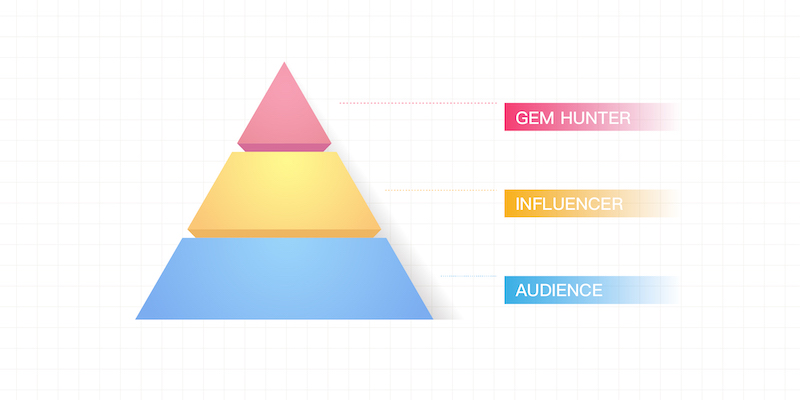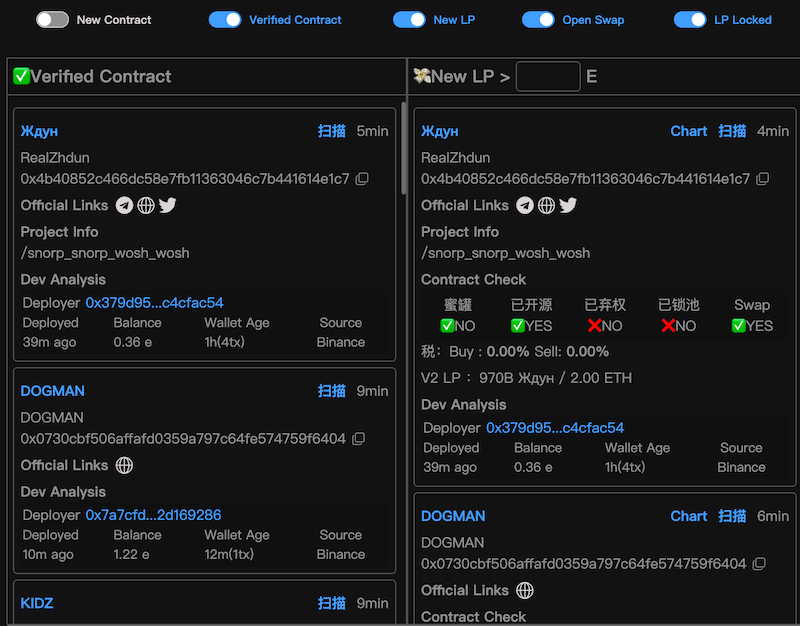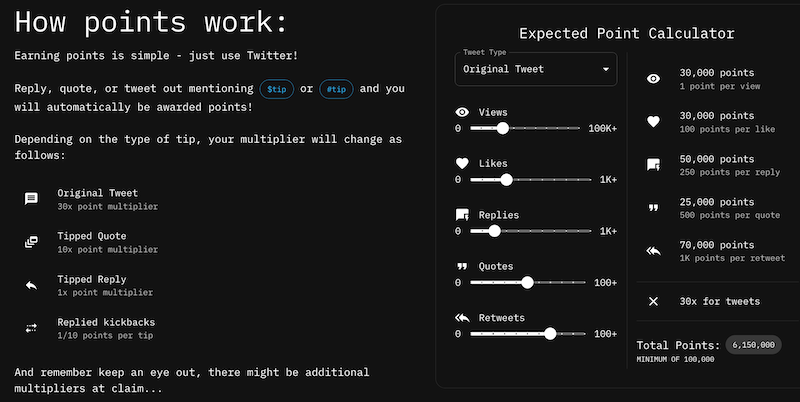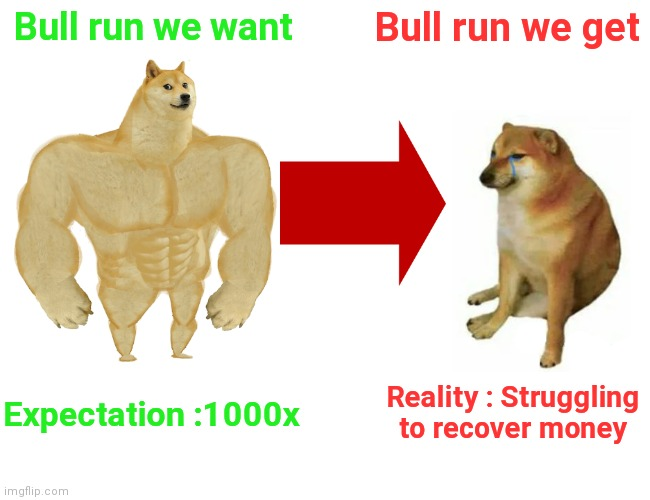Author: @Confetti4bot
Traffic Conduction of Web3 Community in PVP Mode
Recently, the number of stablecoins in the cryptocurrency market has shown a continuous decline. Without new incremental capital injection, traders' profits mainly depend on internal market games, a mode we refer to as PVP mode. In PVP mode, due to the lack of external funds, every short-term speculative opportunity becomes particularly precious, thus becoming the focus of traders' close attention. For these opportunities, information conduction is key. So, how do these speculative information spread and conduct among traders?
In the cryptocurrency market, the process of information transmission forms a hierarchical structure. From the source to the end, there is a clear difference between the recipients of the information and their interests.
- Gem Hunter: These players are the first recipients of information. They are usually able to quickly capture opportunities and buy in when the project is still in its initial stage or when liquidity is first deployed. Their investment amount is usually relatively small, about 0.1-1 ETH, and when they buy in, the project's market value is very low, usually between 20,000 to 200,000 USD. Once the price stabilizes, these players will choose to exit for profit.
- CT's Influencer: When a token's market value has stabilized and shows significant growth potential, these influencers will take notice. As these tokens have certain potential, CT's influencers will publicly promote them to enhance their influence in the community.
- CT's Audience: These are the terminal recipients of information. Most of the time, they are passive information consumers. They rely on the recommendations of influencers and then make investment judgments based on the information they receive.
These three levels together form the information transmission and decision-making mechanism in the cryptocurrency market.

To help readers better understand, this is the tool interface usually used by gem hunters:

Social Mining Algorithm of Tipcoin
In addition to the 10,000 point reward obtained from the initial tweet, TipCoin also provides four ways for users to obtain additional points through "daily tasks." Unlike in Epoch 1, in Epoch 2, points will only increase within 24 hours after the original tweet is published. Each task, such as reading, liking, replying, quoting, and retweeting tweets, has a detailed point calculation formula, which can be viewed on the official website.
- Original Tweet: Publishing original tweets containing the $tip and @tipcoineth tags is the main way to earn points, with a base point multiplier of 25. Depending on activities such as reading, liking, replying, quoting, and retweeting the tweet, points will receive additional bonuses. Up to 5 tweets of this kind can earn points each day.
- Tipped Quote: If your original tweet with the $tip and @tipcoineth tags is quoted by others, you can earn points with a base point multiplier of 10. Up to 10 quotes of this kind can earn points each day, with a maximum of 1 million points. However, excessive quoting may result in points being deducted, with a maximum deduction of 10,000 points.
- Tipped Reply: Replying to others' tweets with the $tip and @tipcoineth tags can earn points with a base point multiplier of 1. Up to 50 replies of this kind can earn points each day, with a total point limit of 25,000. In addition, these replies can also receive additional point bonuses based on factors such as reading and liking.
- Replied Kickbacks: When you receive replies from others, you can also earn points, but at a multiplier of 1/10 of the original points. There is no daily limit to this method, and these points will not be displayed on the user dashboard.

The Secret Behind Tipcoin's Success
Faced with a limited budget, achieving maximum traffic exposure is undoubtedly a challenge. If I had enough funds, I could choose to sponsor Zhou Guanyu's F1 car or name the Miami Heat's arena. But the reality is that my budget is limited. So, how do we solve this problem? Here, I would like to share a key word: expectation.
Taking tipcoin as an example, if it has issued tokens, users can clearly calculate the $TIP income they can obtain by publishing tweets. If this income exceeds the market price, a large number of people will rush in until the resources are exhausted; conversely, if it is lower than the market price, tipcoin may be ignored.
And points, initially promoted by blur, have become an effective strategy to attract users to achieve specific goals. Point mining has two major advantages: 1. It can guide users to achieve established KPIs without explicitly revealing the calculation formula; 2. Although points continue to grow, the corresponding token quantity is fixed, allowing users to engage in strategic games within a limited budget.
Creating sufficient expectations is the first and most crucial step.

Product Analysis of Tipcoin
Tipcoin's product page belongs to a product with strong Paradoxical implications, much like the pink light of a barbershop, the lewd smile of a massage parlor manager, and the second floor of a water club: the homepage of the product clearly shows a message: we have airdrops, and what do you need to do to get more airdrops, and you are likely to receive these airdrops.
While this product design is intuitively simple, it is often overlooked by many Web3 product developers. You may ask, why is this point worth mentioning separately? The answer is: because many Web3 products do not fully understand and consider their target users. I completely understand that as developers, we always want to present every detail and function of the product to users. But in reality, Web3's user base often pursues efficiency, and they will not have much patience to delve into every detail. (Usually, the product details you develop are not as good as the user experience of web2 products.) Therefore, for developers, the key is to highlight the most important and core functions (preferably related to trading and tokens), simplify other operations, and make the user experience smoother.

Token Economy
35% of the TIP tokens will be used for platform rewards, 5% will be allocated to the market, and 5% will be allocated to team lockups. The remaining tokens will be allocated to three Epoch rewards. The distribution ratio of TipCoin's airdrop tokens will be adjusted according to the different Epochs participated in, with 15% used for liquidity provision and 15% for airdrops in Epoch 1; 20% of tokens used for airdrops in Epoch 2; and 5% of tokens used for airdrops in Epoch 3. It should be noted that points not redeemed by the end of the next Epoch will be destroyed.
The goal of TipCoin is to balance rewarding early users, successful product and platform launches, and expanding emissions to achieve price appreciation. TipCoin retains 35% of the tokens for users and locks 5% of the tokens, increasing a significant portion of liquidity supply to assist with issuance and price stability, as well as Epoch rewards, gradually injecting new tokens into the ecosystem, and ultimately using tokens on the new platform to bring quantity and demand.
Some users have pointed out that some users' activities on the leaderboard have been manipulated, however, TipCoin did not immediately pull every user, but chose to internally tag to allow the system to have a more comprehensive understanding of bot activity, so that it can be quickly and effectively addressed in future Epochs. During the points redemption phase, manipulated accounts will lose a large number of points, flowing back into the hands of truly supportive users.
Summary
Friend.Tech used the user "reputation" inherited from X (Twitter) for cold start, while Tipcoin used X's traffic algorithm for cold start. Faced with the emergence of Tipcoin, I encountered two viewpoints: some believe that this viral cold start strategy is extremely efficient and should be adopted by more projects; while others are concerned that when social interaction is no longer based on real interaction, but instead pursues KPI-driven point accumulation, how long can such popularity be sustained?
Personally, I tend to support and encourage this focused innovative strategy. In the Web2 domain, the most profitable area is computational advertising. Taking TikTok as an example, it generates about $10 billion in revenue annually through computational advertising. Computational advertising focuses on using machine learning models to optimize advertising decisions, a field that has evolved over 20 years to reach its current maturity. In comparison, the social domain of Web3 is still in its early stages, and its development trajectory is very similar to the early days of computational advertising. Regardless of whether Epoch 2 of tipcoin can be sustained, this is a meaningful social experiment.
免责声明:本文章仅代表作者个人观点,不代表本平台的立场和观点。本文章仅供信息分享,不构成对任何人的任何投资建议。用户与作者之间的任何争议,与本平台无关。如网页中刊载的文章或图片涉及侵权,请提供相关的权利证明和身份证明发送邮件到support@aicoin.com,本平台相关工作人员将会进行核查。




